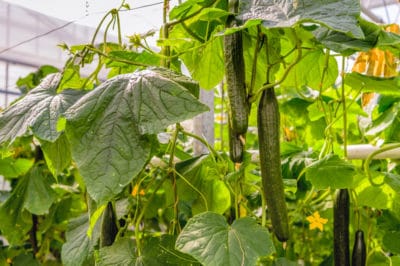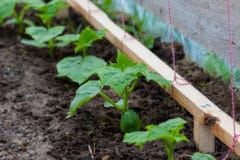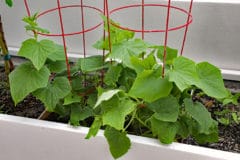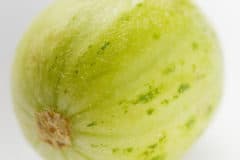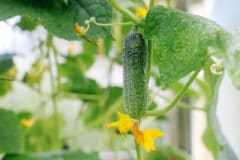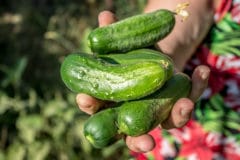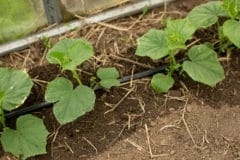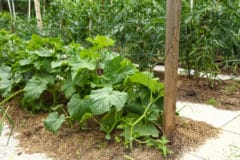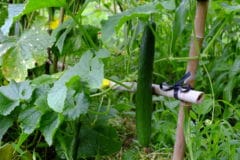How much room do cucumbers need?
Vining cucumbers left to sprawl on the ground cover about 15 square feet (1.4 square meters) each. If your garden can’t accommodate them, one option is to grow them vertically on a trellis or fence. Another is to plant bush cucumbers that grow full-sized fruit in just 2 to 3 square feet (.18 to.26 square meters).
Expert gardener’s tip: Because they need only minor staking, bush cucumbers also grow well in containers.
How much sun do my cucumbers need?
To thrive, your cucumbers need between six and nine hours of daily sun. The more they get, the bigger your harvest will be. If summer temperatures in your area frequently exceed 95°F (35°C), however, your plants will benefit from filtered afternoon shade.
What’s the best soil for growing cucumbers?
Cucumbers need rich, loose soil with plenty of organic matter. If yours doesn’t qualify, improve it one month before planting by working in plenty of organic compost, worm castings or well-aged manure from organically raised livestock.
When’s the best time to plant my cucumbers?
Cucumber seeds won’t sprout until after the soil has warmed to 65° F (18.3°C). To know exactly when that is, get a soil thermometer and average the morning and afternoon temperatures for several days. Plant only after the daily average persistently reads higher than 65°F (18.3°C).
How do I plant my cucumber seeds?
Plant your seeds in groups atop circular, flat-topped hills. This method keeps the soil warmer. It also improves the plants’ water and nutrient uptake and gives their roots room to spread. To make the hills:
- Loosen the soil to break up large clods and then rake it to create a smooth surface.
- Hoe the soil into small hills about 10 inches (24.4 cm) high. Tamp the tops of the hills into circles about 1 foot (30.4 cm) across.
- Space from four to six seeds evenly around the perimeter of each circle and press them 1 inch (2.4 cm) into the soil.
- Mist each planting lightly with water until its hill is evenly moist. A heavy spray or stream of water may dislodge the seeds.
How do I care for my cucumber seedlings?
Keep the soil moist enough to crumble just slightly when you squeeze a handful. Remove weeds as soon as they sprout. When the seedlings are 3 to 4 inches (7.2 to 9.6 cm) tall, thin all but the strongest two from each hill. Then spread 2 or 3 inches of organic mulch over each hill to within a few inches of each seedling.
Expert gardener’s tips:
- By keeping the soil warm and moist, organic mulches such as chopped or shredded leaves speed the plants’ growth. They also protect the spreading vines from soil-borne diseases.
- To guard your seedlings against cucumber beetles, melonworm and pickleworm moths or whiteflies, drape the hills with fabric row covers. The covers keep flying insects out while letting air, sun and rain in. The plants push the featherlight material up as they grow.
How often should I water my cucumbers?
To produce flowers and fruit, cukes need about 1 inch (2.4 cm) of rain or water each week. In weeks with no rain, that equals 6 gallons (22.7 liters) of supplemental water for every 10 square feet (.92 square meters) of soil. Watering the plants around their bases early in the morning helps prevent disease.
Do I need to fertilize my cucumbers?
Cukes produce best when fed with a balanced organic fertilizer as soon as their first flowers appear. Look for a granular, slow-release formula with equal N-P-K numbers on the label and apply it at the manufacturer’s recommended rate. Organic fertilizer improves the soil’s texture. It also supports the soil microbes that deliver nutrients to your plants.
Besides saving space, are there advantages to trellising cucumbers?
Even if your garden gives cukes room to roam, trellising them is still a good idea. Vertical vines are more likely to produce straight, regularly shaped fruit. Improved air flow around their leaves discourages powdery mildew leaf fungus. Finally, trellised plants are much easier to harvest than sprawling ones.
How can I be sure my cucumbers won’t taste bitter?
Cucumber leaves deter insects with bitter-tasting compounds that may leach into the fruit when the plants are stressed. Proper growing conditions – including organically fertilized soil, plenty of water during hot dry spells and adequate sun each day — go a long way toward avoiding the problem. Planting varieties that are labeled “non-bitter,” such as ‘Armenian’ or ‘Eversweet,’ also helps.
